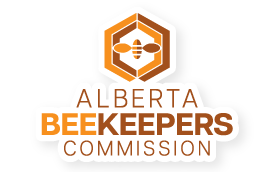Winter Bees and Clustering Behavior – Part 2
On last month’s ‘Winter Bees and Clustering Behavior’ article we discussed the winter population demographics and how and when winter bees are produced. Here, we will talk about how the winter cluster works and what they do to keep the colony alive during the coldest months of the year!

Figure 1. Cluster dynamics of a honey bee colony during the winter months. The red represents the cluster core, housing the queen and brood which is maintained at 33°C. The heater bees are at a slightly cooler temperature, in the orange circle. The blue outer circle is the insulator bees, where the temperatures range from 6-12°C. The outer frames in yellow are honey frames.
Honey bee colonies survive the winter by keeping themselves warm in a very efficient way, similar to how penguin colonies maintain and generate heat in the winter. As temperatures drop in the fall, the bee colony forms a tight cluster with the queen and brood at the centre, surrounded by heat-generating bees. While older bees are found on the periphery of the cluster, forming an outer insulating layer of tightly packed bees with their heads towards the centre. These tightly packed bees perform an important task of trapping heat inside of the cluster by interlacing their feather-like hairs. If it gets colder, the cluster will contract and tighten even more to hold in more heat and will disperse and contract again with changing temperatures. When temperatures drop below -10 C, the bees inside the cluster (‘heater bees’) start vibrating their flight muscles, just like shivering, to heat up themselves and consequently, the entire cluster. This high-energy demanding task requires the bees to consume honey, which is then metabolized in the flight muscles.
The outer edges of the winter cluster will be between 6-12°C. But once brood rearing initiates, the cluster must work harder to maintain an internal temperature of ~33°C. The larger the cluster, the more efficient it is at generating heat, maintaining temperatures, and rearing brood for the spring – hence the need to combine small colonies in the fall!
Throughout the winter, the cluster will move together to different parts of the hive to access stored food. On warm days, bees will exit the hive to defecate, but until then the bees remain in the cluster.
Ventilation
During the winter, the cluster will produce heat, water vapor, and carbon dioxide (CO2). As the cluster creates heat, the warm air rises. Once it hits the cooler temperatures outside the cluster, the water vapor trapped in the warm air condenses. If the hive is not properly ventilated, there will be an excess moisture, heat, and CO2 which can be detrimental to the colony. Proper ventilation maintains these levels and creates the right in-hive environment for the bees.
Insulation for outdoor wintering
Providing good insulation, especially here in Alberta, is a necessary protection for your bees against the cold winter weather. The better a hive is insulated, the less work the bees must do to maintain the cluster temperatures. This means the bees will consume fewer resources, reducing the possibility of starvation. Colonies are often wrapped together in pairs or groups of four. This limits the sides of the hive that are exposed to the elements and is also more efficient when wrapping large numbers of colonies.
There are many options when it comes to wrapping your hives but some factors to consider when choosing are:
• A dark outer surface increases heat absorption from the limited amount of sun
• Adding an absorptive layer on top of the hive to absorb moisture (such as insulation, cork, burlap, or wood shavings)• Good upper entrance ventilation
• Entrance reducer to reduce drafts and prevent snow, rain, and animals from entering
• Waterproof
• Somewhat mouse resistant
• Easy to use
It is also important to choose a wintering site that is sheltered from the wind or manufacturing a windbreak yourself. Hay bails or a fence can be used to block the wind and protect your hives.
During part 1 & 2 of this winter bee and clustering behaviour series, we covered how bee colonies prepare for the winter and what happens inside the hive during the winter. But what can you, as a beekeeper do to help them out? The conditions under which winter bees develop are important to consider when preparing colonies for winter. We often don’t think of winter until the leaves begin to change in the fall, but honey bees begin preparing much earlier.
The bees that will sustain the colony throughout the winter begin developing in early August, often before any kind of management or treatment is applied to the colony. If varroa infestation level is high at that time and treatments are not applied until the late fall, winter bees will develop under the stress of a varroa infestation and damage will be done before disease management starts. Varroa mites feed on the bee hemolymph and fat bodies, which are essential for overwintering bees and the success of the colony over winter. Small changes can go a long way. If we shift our focus to disease management earlier in the season, our colonies will be much healthier when winter bees are being developed and much better prepared for the upcoming winter.
